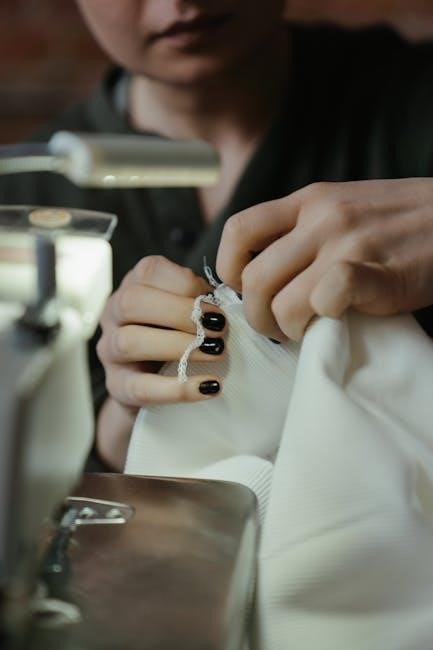Welcome to the Singer Sewing Machine Operation Manual․ This guide provides essential information for understanding and operating your machine effectively, covering setup, maintenance, safety, and troubleshooting to ensure optimal performance and longevity․
1․1 Overview of the Manual
This manual is designed to guide you through the safe and effective operation of your Singer sewing machine․ It covers essential topics such as setup, basic operation, maintenance, and troubleshooting․ The manual is organized into clear sections, making it easy to navigate and understand․ Whether you’re a beginner or an experienced user, this guide provides detailed instructions to help you maximize your machine’s performance․ Topics include threading, stitching, tension adjustment, and proper care to ensure longevity․ Diagrams and step-by-step instructions are included to simplify complex tasks․ By following this manual, you’ll be able to use your Singer sewing machine confidently and efficiently․
1․2 Importance of Reading the Manual
Reading the Singer Sewing Machine Operation Manual is crucial for safe and effective use of your machine․ It provides detailed instructions for setup, operation, and maintenance, ensuring optimal performance․ The manual highlights safety precautions to prevent accidents and machine damage․ Understanding proper threading, tension adjustment, and stitch selection is essential for achieving professional results․ Additionally, troubleshooting guides help resolve common issues quickly․ Regular maintenance routines, such as cleaning and oiling, are outlined to extend the machine’s lifespan․ By following the manual, you can avoid costly repairs and ensure your Singer sewing machine operates efficiently for years to come․
1․3 Safety Precautions
Always prioritize safety when operating your Singer sewing machine․ Switch the machine off when making adjustments near the needle area, such as threading or changing the bobbin․ Keep loose clothing and long hair tied back to avoid entanglement․ Ensure the work area is clean and well-lit to prevent accidents․ Never leave the machine unattended while it is in operation․ Keep children and pets away from the machine․ Use the correct presser foot for your fabric type to maintain control․ Handle sharp objects like needles and scissors with care․ Following these precautions ensures safe and effective operation of your Singer sewing machine․

Setting Up Your Singer Sewing Machine
Setting up your Singer sewing machine involves unpacking, inspecting, and identifying parts․ Place it on a stable surface for optimal operation․ Refer to the manual for detailed guidance․
2;1 Unpacking and Initial Inspection
When unpacking your Singer sewing machine, handle it with care to avoid damage․ Inspect the machine for any visible damage or defects․ Check all accessories, such as the power cord, presser feet, and bobbin, to ensure they are included and undamaged․ Verify that the machine is suitable for your power supply․ Remove any packaging materials carefully to avoid scratching the surface․ Before first use, ensure all components are securely attached and functioning properly․ Refer to the manual for guidance on identifying parts and preparing the machine for operation․
- Check for any signs of shipping damage․
- Ensure all listed accessories are present․
- Inspect the power cord and plug for integrity․
- Remove all packaging materials safely․
2․2 Identifying Machine Parts and Components
Familiarizing yourself with the Singer sewing machine’s parts is essential for proper operation․ Locate the spool pins, tension discs, take-up lever, and stitch length regulator․ The bobbin case, feed dogs, and presser foot are crucial for fabric movement․ Identify the power switch, handwheel, and reverse stitch lever for control․ The needle bar and hook assembly are vital for stitching․ Ensure you understand the function of each component before use․ Refer to the manual’s diagrams for accurate identification and descriptions․ Proper knowledge of these parts will enhance your sewing experience and troubleshooting abilities․
- Spool pins and tension discs for thread management․
- Bobbin case and feed dogs for fabric handling․
- Presser foot and stitch length regulator for stitch control․
- Power switch and handwheel for machine operation․
2․3 Placing the Machine on a Stable Surface
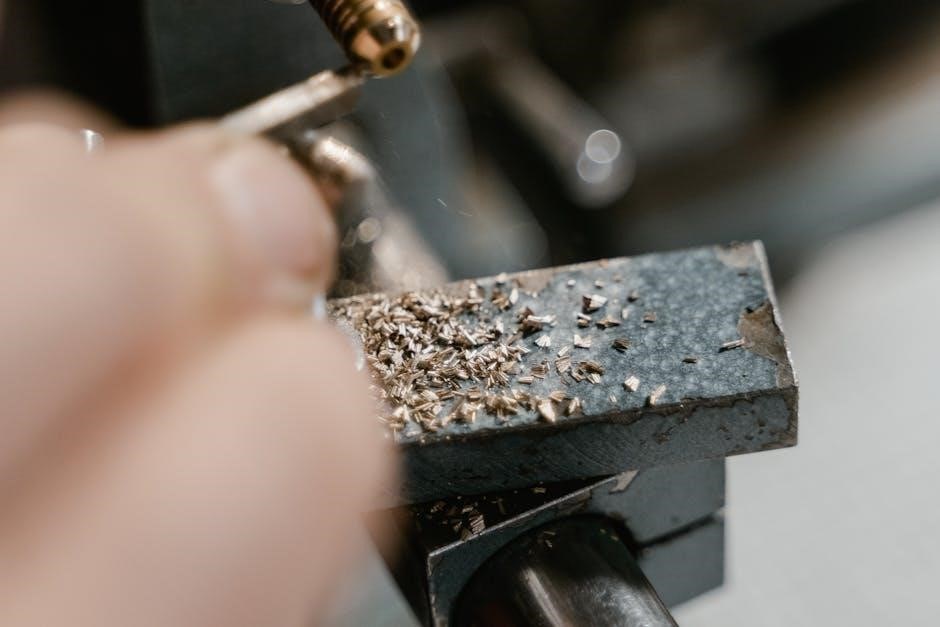
Positioning your Singer sewing machine on a stable, flat surface is crucial for smooth operation․ Choose a sturdy table or countertop to prevent vibration and ensure even stitching; Avoid uneven or wobbly surfaces, as they may cause machine instability․ Place the machine away from direct sunlight to avoid overheating and keep it at a comfortable height for easy access․ Ensure the surface is clean and free from dust or moisture to maintain optimal performance․ Proper placement enhances accuracy and reduces the risk of mechanical issues, ensuring a better sewing experience․
- Use a sturdy, flat surface for stability․
- Avoid uneven or wobbly tables․
- Keep the machine away from direct sunlight and moisture․
- Ensure the surface is clean and dry․
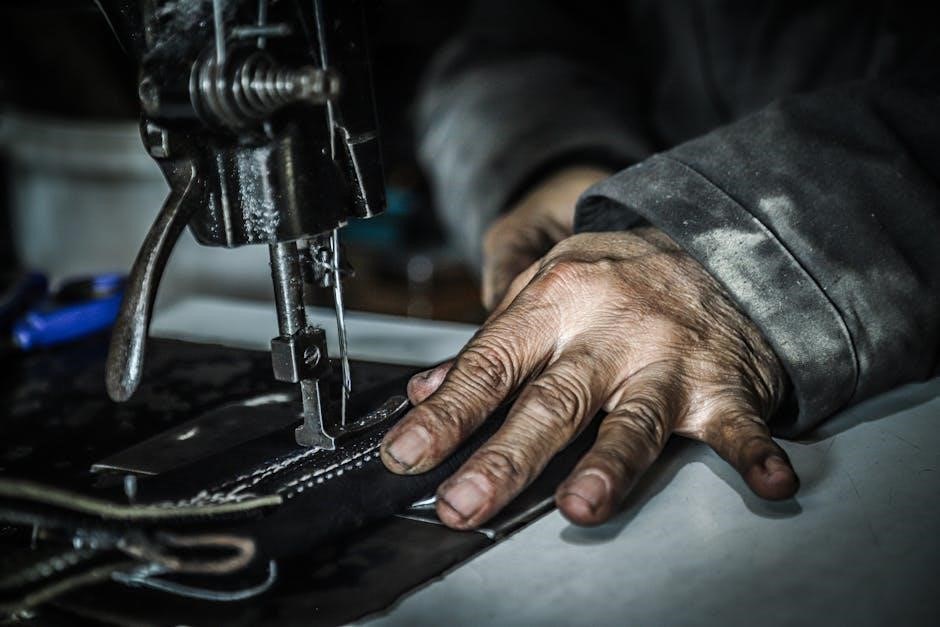
Basic Operation of the Singer Sewing Machine
Master the basics of Singer sewing machine operation․ Start by turning it on, selecting your stitch type, and ensuring the bobbin area is secure․ Always keep the machine at room temperature for optimal performance․
- Turn on the machine and select the desired stitch type․
- Ensure the bobbin area is properly closed during operation․
- Maintain room temperature for consistent stitching results․
3․1 Threading the Machine
Proper threading is essential for smooth operation․ Begin by turning the machine off and locating the spool pin․ Guide the thread through the tension discs, ensuring it’s seated correctly․ Pass the thread through the take-up lever and then insert it into the needle’s eye from front to back․ Keep the thread taut but not overly tight․ Avoid crossing threads, as this can cause tangles․ Use high-quality thread suitable for your fabric type․ If threading is unclear, refer to the manual or Singer’s online resources for specific guidance․ Proper threading ensures even stitches and prevents machine malfunction during operation․
3․2 Winding and Inserting the Bobbin
To wind the bobbin, start by cutting a small piece of thread and inserting one end through the bobbin’s hole․ Wind the thread evenly around the bobbin, keeping it taut but not overly tight․ Avoid overfilling, as this can cause uneven stitching․ Once wound, cut the thread, leaving a small tail․ Next, insert the bobbin into the machine’s bobbin case, ensuring it clicks securely into place․ Gently pull the thread tail to ensure the bobbin is properly seated․ Close the slide over the bobbin case to maintain proper tension during operation․ Always use the correct type of thread for your fabric to ensure optimal results․
3․3 Selecting the Correct Stitch Type
Selecting the right stitch type is crucial for achieving professional results․ Your Singer sewing machine offers various stitches, including straight, zigzag, and decorative options․ Choose the stitch based on fabric type and desired outcome․ For example, use straight stitches for woven fabrics and zigzag for stretchy materials․ Consult the manual for specific stitch recommendations․ Always test the stitch on a scrap fabric before sewing your final project․ Adjusting the stitch length and width ensures optimal results․ Proper stitch selection enhances durability and appearance, making your sewing projects stand out․ Remember to switch off the machine when changing stitch settings for safety․
3․4 Adjusting Tension for Optimal Stitching
Proper tension adjustment is essential for achieving consistent and high-quality stitches․ Ensure the machine is turned off before making any adjustments․ Check the bobbin and spool tension regularly, as incorrect tension can lead to uneven stitching or thread breakage․ Refer to your manual for specific guidance on adjusting tension discs and springs․ Always test stitches on scrap fabric after adjustments․ Extreme temperatures can affect tension, so maintain a stable environment; Proper tension ensures smooth operation and prevents damage to the machine․ Regularly cleaning and oiling the machine also supports optimal tension performance․ Adjusting tension correctly enhances stitch quality and extends machine longevity․
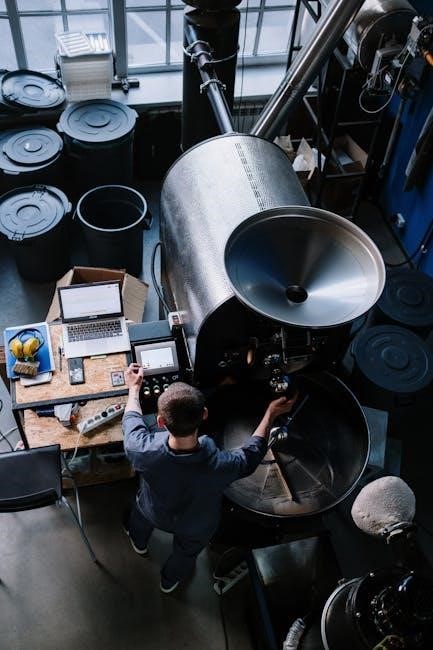
Maintenance and Care
Regular cleaning and oiling are crucial for optimal performance․ Always turn off the machine before servicing․ Clean lint and debris from the bobbin area and tension discs․ Oil internal mechanisms as recommended to prevent wear․ Check for loose parts and tighten them․ Follow the maintenance schedule in your manual to ensure longevity․ Proper care extends the life of your Singer sewing machine and maintains its efficiency․ Regular servicing prevents mechanical issues and ensures consistent stitching quality․ Keep the machine in a dry, cool place to avoid rust and damage․ Proper maintenance is key to years of reliable service․
4․1 Cleaning the Machine
Regular cleaning is essential for maintaining your Singer sewing machine’s performance․ Turn off the machine and unplug it before cleaning․ Use a soft brush to remove dust, lint, and thread fragments from the exterior and interior, including the bobbin area․ Dampen a cloth with water for stubborn stains, but avoid harsh chemicals or excessive moisture․ Clean the bobbin case and feed dogs gently to prevent damage․ For tight spaces, use compressed air carefully․ Never submerge the machine in water or use liquid cleaners, as this can damage electrical components․ Regular cleaning ensures smooth operation and extends the machine’s lifespan․
4․2 Oiling the Machine
Regular oiling is essential to maintain your Singer sewing machine’s performance and longevity․ Use high-quality sewing machine oil, applying a few drops to the specified parts, such as the bobbin area and tension discs․ Oil the machine after every 10 hours of use or as needed․ Turn off the machine and unplug it before oiling to ensure safety․ Avoid over-oiling, as it can attract dust and cause residue buildup․ Always refer to the manual for specific oiling points․ Proper lubrication ensures smooth operation, prevents wear, and keeps your machine running efficiently for years․
4․3 Regular Maintenance Schedule
Regular maintenance is crucial for ensuring your Singer sewing machine operates smoothly․ Clean the machine daily after use, focusing on the bobbin area and feed dogs․ Oil the machine every 50 hours of use or as specified in the manual․ Check and replace needles regularly to prevent damage․ Every 6 months, inspect the tension discs and take-up lever for proper alignment; Lubricate moving parts and ensure the bobbin case is free from lint․ Schedule professional servicing annually to maintain optimal performance and extend the machine’s lifespan․ A consistent maintenance routine will keep your Singer sewing machine in excellent working condition․
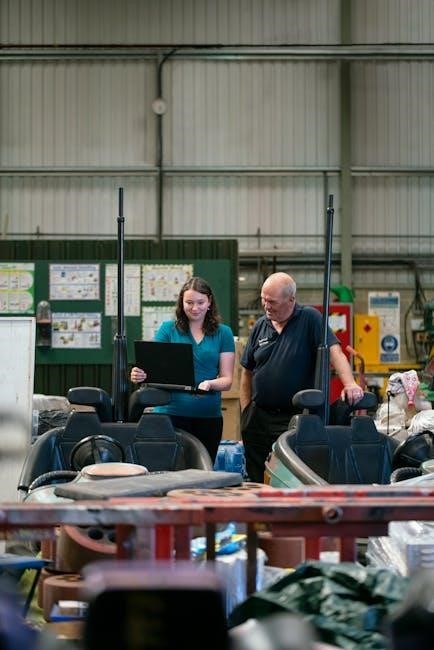
Troubleshooting Common Issues
This section addresses frequent problems like thread breakage, uneven stitching, and machine startup issues․ Refer to the manual for step-by-step solutions to ensure smooth operation․
5․1 Thread Breakage
Thread breakage is a common issue that can disrupt your sewing process․ It often occurs due to improper threading, tension imbalance, or using low-quality thread․ To resolve this, check the spool for tangles and ensure the thread is properly seated in the machine’s tension discs․ Re-thread the machine following the manual’s guidelines, and adjust the tension settings if necessary․ Using the correct needle size for your fabric can also prevent breakage․ If the issue persists, consult the troubleshooting section or contact Singer support for assistance․ Regular maintenance, like cleaning and oiling, can help minimize thread breakage and ensure smooth operation․
5․2 Uneven Stitching
Uneven stitching can occur due to incorrect tension settings, improper threading, or using the wrong needle size․ To resolve this, check the thread tension on both the top and bobbin․ Ensure the machine is properly threaded and that the bobbin is correctly inserted․ Using the right needle type and size for your fabric is crucial․ If issues persist, adjust the stitch length and width․ Keep the slide over the bobbin case closed during operation to maintain consistent stitching․ Regularly cleaning and oiling the machine can also prevent uneven stitching․ Consult the manual for specific adjustments or contact Singer support for further assistance․
5․3 Machine Not Turning On
If your Singer sewing machine fails to turn on, first check the power source․ Ensure the machine is properly plugged into a functioning electrical outlet․ Verify that the power switch is in the “on” position․ If the issue persists, inspect the power cord for any visible damage or tangles․ Additionally, ensure that all adjustments, such as threading or bobbin changes, are completed before attempting to start the machine․ If the machine still does not power on, consult the troubleshooting section or contact Singer support for further assistance․ Regular maintenance can also prevent such issues from occurring․
5․4 Bobbin Not Picking Up Thread
If your Singer sewing machine’s bobbin fails to pick up thread, ensure it is properly seated and aligned in the bobbin case․ Check that the bobbin is inserted correctly, with the thread passing through the tension spring․ Verify that the machine is threaded correctly and that the take-up lever is in the correct position․ Clean the bobbin area to remove any lint or debris that may interfere with thread pickup․ If issues persist, consult the manual or contact Singer support for further assistance․ Proper maintenance and regular cleaning can help prevent this issue․ Always follow the manufacturer’s guidelines for optimal performance․
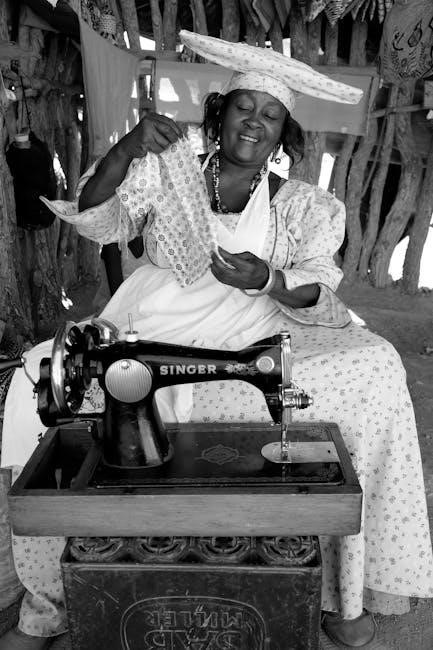
Advanced Features and Techniques
Explore advanced techniques like using various presser feet for specialized sewing tasks, sewing different fabrics with adjusted settings, and creating decorative stitches for enhanced creativity․
6․1 Using Different Presser Feet
Using different presser feet enhances your sewing experience by allowing you to handle various fabrics and techniques with precision․ The zipper foot is ideal for sewing zippers and piping, while the blind hem foot is perfect for invisible hems․ Other specialized feet, like the walking foot or Teflon foot, help with thick fabrics or smooth stitching on delicate materials․ Always attach the correct foot for your project to ensure even feeding and professional results․ Refer to your Singer sewing machine manual for specific foot compatibility and installation instructions to maximize your machine’s versatility and achieve flawless stitching every time․
6․2 Sewing Various Fabrics
When sewing with your Singer machine, it’s essential to adjust settings based on fabric type․ For delicate fabrics like silk or cotton, use a sharp needle and lighter tension․ Heavier fabrics, such as denim or canvas, require a heavy-duty needle and increased tension․ Always test stitches on scrap fabric to ensure optimal results․ Use the appropriate presser foot for the fabric type, such as the zipper foot for thick materials․ Adjusting the stitch length and width can also enhance performance on different fabrics․ Proper fabric handling and machine setup ensure professional-looking seams and extend the life of your Singer sewing machine․
6․3 Creating Decorative Stitches
Enhance your sewing projects with decorative stitches using your Singer sewing machine․ Many models offer a variety of built-in decorative stitch options, from floral patterns to geometric designs․ To create decorative stitches, select the desired stitch type using the control panel or dial, depending on your machine model․ Adjust the stitch length and width for the best results․ Use contrasting thread colors to make your stitches stand out․ Experiment with different fabrics and presser feet, such as the zigzag or satin stitch foot, to achieve professional-looking finishes․ Regularly test stitches on scrap fabric to ensure proper tension and alignment․ This feature allows for endless creativity in embroidery, quilting, and home decor projects․
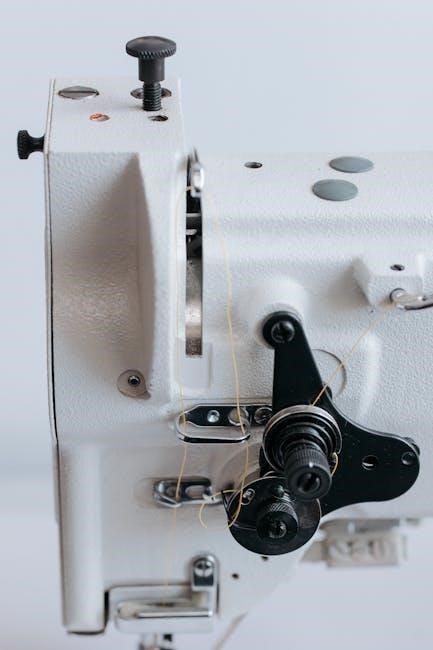
Accessories and Attachments
Explore Singer sewing machine accessories like presser feet, extension tables, and specialized attachments․ These tools enhance functionality, enabling tasks such as zippers, hems, and decorative stitching with precision․
7․1 Overview of Available Accessories
The Singer sewing machine offers a variety of accessories to enhance your sewing experience․ These include presser feet for specific tasks, such as zipper, blind hem, and buttonhole feet, which simplify complex stitching․ Additional accessories like extension tables, quilting guides, and specialized needles ensure versatility for different fabrics and projects․ Singer also provides bobbin cases, threaders, and seam rippers to streamline your workflow․ These accessories are designed to optimize performance and expand the machine’s capabilities, making it suitable for both beginners and advanced sewists․ Visit Singer’s official website or authorized dealers to explore the full range of compatible accessories for your machine․
7․2 Using the Zipper Foot
The zipper foot is a specialized accessory designed for sewing zippers and other narrow or bulky materials․ To use it, attach the foot to your Singer machine by snapping it onto the presser foot holder․ Align the zipper teeth with the foot’s edge, ensuring the fabric is guided smoothly․ The zipper foot allows for precise control, preventing the fabric from slipping and ensuring straight stitching․ It’s ideal for bags, clothing, and home decor projects․ Always refer to your machine’s compatibility list to ensure the zipper foot is suitable for your specific Singer model․ This accessory enhances your sewing versatility and accuracy․
7․3 Using the Blind Hem Foot
The Blind Hem Foot is a specialized accessory designed for sewing invisible hems, ideal for garments and home decor․ To use it, attach the foot to your machine according to the manual․ Position the fabric edge under the foot, aligning the hem with the guide․ Select a blind hem stitch and adjust the stitch width․ Sew slowly, ensuring the fabric feeds smoothly․ This foot is perfect for creating professional-looking hems without visible stitching․ Practice on scrap fabric to achieve the best results․

Sewing Machine Safety Guidelines
Always turn off the machine when adjusting needles or bobbins․ Keep loose clothing tied back and avoid hot or cold extremes․ Handle sharp objects carefully to prevent accidents․
8․1 General Safety Tips
Always prioritize safety when operating your Singer sewing machine․ Keep children and pets away while sewing․ Avoid wearing loose clothing or jewelry that could get caught․ Ensure the machine is placed on a stable surface․ Never touch sharp parts like needles or cutters․ Keep fingers away from the needle area while sewing․ Use the correct needle type for your fabric to prevent breakage․ Avoid sewing over pins, as they can cause injury․ Keep the work area well-lit and clear of clutter․ Turn off the machine when making adjustments or changing parts․ Proper handling ensures safe and efficient sewing experiences․
8․2 Avoiding Accidents
To ensure safe operation, always switch the machine off when making adjustments near the needle area, such as threading or changing the bobbin․ Keep loose clothing and long hair tied back to avoid entanglement․ Never touch moving parts with your hands or fingers, and avoid sewing over pins․ Use the provided presser feet and attachments correctly to prevent fabric slippage․ Keep children and pets away while operating the machine․ Regularly inspect and maintain the machine to prevent mechanical failures․ Proper handling of sharp objects like needles and scissors is essential to avoid injuries․ Follow all safety guidelines to enjoy a safe and efficient sewing experience․
8․3 Proper Handling of Sharp Objects
When working with your Singer sewing machine, always handle sharp objects like needles, scissors, and cutters with care․ Ensure needles are securely inserted and changed only when the machine is turned off․ Use protective devices like needle guards or thimbles to prevent injuries․ Store sharp tools in a safe place, out of children’s reach․ Avoid leaving sharp objects near the machine while it’s in operation․ Proper handling reduces the risk of accidents and ensures a safer sewing environment․ Always dispose of used needles responsibly to prevent potential harm․

Warranty and Support Information
Your Singer sewing machine comes with a comprehensive warranty․ Visit the official Singer website for detailed warranty terms, support contact information, and downloadable resources to assist you․
9․1 Understanding Your Warranty
Your Singer sewing machine comes with a comprehensive warranty designed to protect your investment․ The warranty period typically covers parts and labor for defects in materials and workmanship․ Registration is often required to activate the warranty, ensuring seamless support․ Coverage varies by model, but most include repair or replacement of faulty components․ Keep your proof of purchase handy, as it may be required for warranty claims․ For detailed terms, refer to the warranty document provided with your machine or download it from Singer’s official website․ Understanding your warranty ensures peace of mind and hassle-free service․
9․2 Contacting Singer Support
For assistance with your Singer sewing machine, visit the official Singer website at https://www․singer․com/support․ Here, you can access free downloadable manuals, troubleshooting guides, and repair resources․ Singer also offers a dedicated customer service team to address inquiries․ Additionally, authorized service centers worldwide provide professional help for complex issues․ For parts and supplies, you can use the Singer online database or contact trusted suppliers․ Remember to register your machine for warranty benefits and updates․ Singer’s support network ensures you receive the help you need to maintain and optimize your sewing machine’s performance․
9․4 Finding Authorized Service Centers
To locate an authorized Singer service center, visit the official Singer website or refer to the manual․ Singer has a global network of authorized service centers that provide professional maintenance, repairs, and genuine parts․ These centers are equipped to handle complex issues and ensure your machine operates at its best․ For international users, Singer also partners with trusted suppliers, such as UK-based distributors, to offer worldwide shipping and support․ Always verify the center’s authorization to ensure genuine Singer service and maintain your machine’s warranty․ Regular visits to these centers can extend your machine’s lifespan and performance․
In conclusion, this manual has guided you through setup, operation, and maintenance of your Singer sewing machine․ Regular practice and proper care ensure optimal performance and longevity․ Refer to Singer’s official resources for additional support and troubleshooting․
10․1 Summary of Key Points
This manual provides a comprehensive guide to operating and maintaining your Singer sewing machine․ It covers essential steps like threading, bobbin management, and stitch selection․ Regular maintenance, including cleaning and oiling, ensures optimal performance․ Safety precautions, such as turning off the machine during adjustments, are emphasized to prevent accidents․ Troubleshooting common issues like thread breakage and uneven stitching is also addressed․ By following the guidelines, you can extend the machine’s lifespan and achieve professional results․ Practice and proper care will help you master various fabrics and decorative techniques, making your Singer sewing machine a reliable tool for all your sewing needs․
10․2 Encouragement to Practice
Mastering your Singer sewing machine takes practice, and consistent effort will enhance your sewing skills․ Start with simple projects to familiarize yourself with the machine’s features and operation․ Experiment with different fabrics and stitch types to build confidence․ Don’t be discouraged by initial mistakes—they are part of the learning process․ Regular practice will help you achieve professional results and unlock the full potential of your machine․ Remember, patience and dedication are key to becoming proficient․ Keep exploring new techniques and enjoy the creative journey with your Singer sewing machine․
10․3 Final Tips for Optimal Machine Performance
For optimal performance, regularly clean and oil your Singer sewing machine to prevent dust buildup and friction․ Store the machine in a dry, cool place to avoid rust and damage․ Always use high-quality threads and needles suitable for your fabric type․ Keep the bobbin area clean and ensure proper thread tension․ Refer to your manual for specific care instructions․ By following these tips, you’ll extend the life of your machine and ensure consistent, professional-grade stitching results․ Happy sewing!
